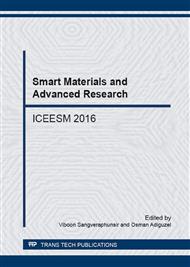p.3
p.7
p.12
p.17
p.22
p.27
p.32
p.37
Effect of Sintering Temperature on (Bi2O3Fe2O3)0.8(Nb2O5)0.2
Abstract:
(Bi2O3Fe2O3)0.8(Nb2O5)0.2 was synthesized by solid state reaction method. (Bi2O3Fe2O3)0.8(Nb2O5)0.2 was made for the investigation of X-ray diffraction (XRD), Scanning Electron Microscopy (SEM) and Dielectric property. XRD pattern reveals that three phases were obtained with Bismuth Iron Niobium Oxide. SEM elicits that grain size increases with the enhancement of sintering temperature. Dielectric property decreases with the augmentation of frequency.
Info:
Periodical:
Pages:
3-6
Citation:
Online since:
January 2017
Keywords:
Price:
Сopyright:
© 2017 Trans Tech Publications Ltd. All Rights Reserved
Share:
Citation:


